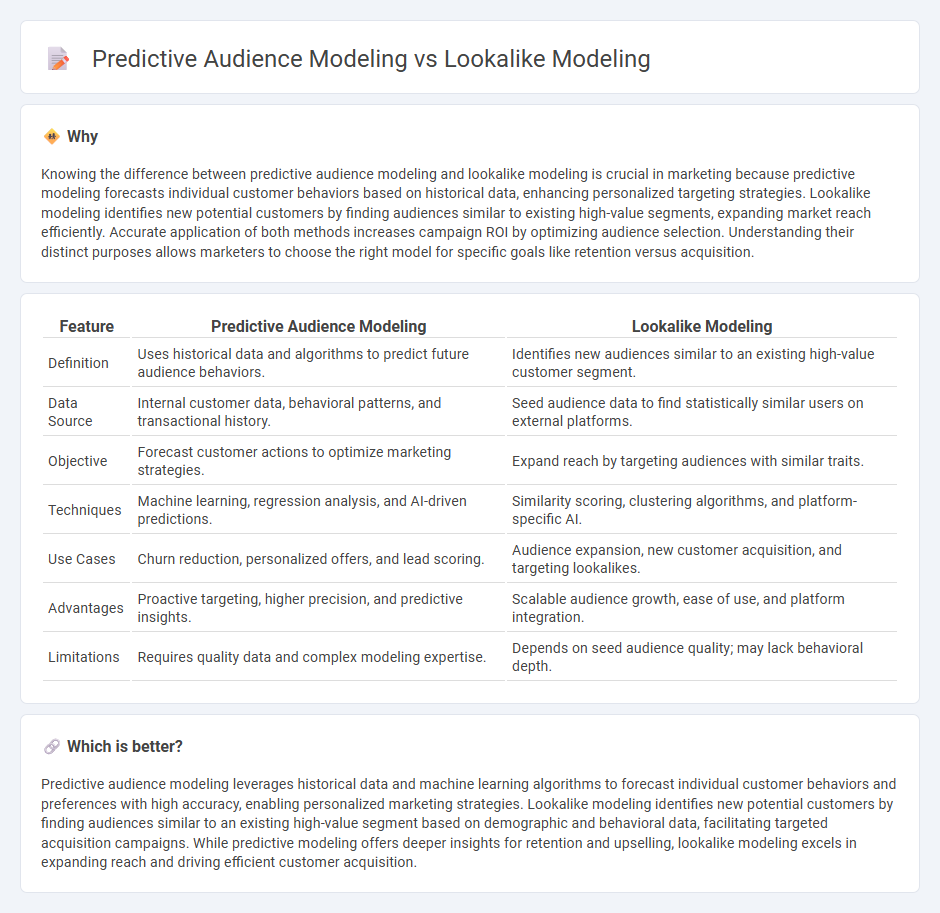
Predictive audience modeling leverages historical data and machine learning algorithms to forecast future consumer behaviors and preferences, enabling highly targeted marketing campaigns. Lookalike modeling identifies new potential customers by analyzing existing audience characteristics and finding similar user profiles within larger datasets. Explore further to understand how these techniques can elevate your marketing strategy.
Why it is important
Knowing the difference between predictive audience modeling and lookalike modeling is crucial in marketing because predictive modeling forecasts individual customer behaviors based on historical data, enhancing personalized targeting strategies. Lookalike modeling identifies new potential customers by finding audiences similar to existing high-value segments, expanding market reach efficiently. Accurate application of both methods increases campaign ROI by optimizing audience selection. Understanding their distinct purposes allows marketers to choose the right model for specific goals like retention versus acquisition.
Comparison Table
| Feature | Predictive Audience Modeling | Lookalike Modeling |
|---|---|---|
| Definition | Uses historical data and algorithms to predict future audience behaviors. | Identifies new audiences similar to an existing high-value customer segment. |
| Data Source | Internal customer data, behavioral patterns, and transactional history. | Seed audience data to find statistically similar users on external platforms. |
| Objective | Forecast customer actions to optimize marketing strategies. | Expand reach by targeting audiences with similar traits. |
| Techniques | Machine learning, regression analysis, and AI-driven predictions. | Similarity scoring, clustering algorithms, and platform-specific AI. |
| Use Cases | Churn reduction, personalized offers, and lead scoring. | Audience expansion, new customer acquisition, and targeting lookalikes. |
| Advantages | Proactive targeting, higher precision, and predictive insights. | Scalable audience growth, ease of use, and platform integration. |
| Limitations | Requires quality data and complex modeling expertise. | Depends on seed audience quality; may lack behavioral depth. |
Which is better?
Predictive audience modeling leverages historical data and machine learning algorithms to forecast individual customer behaviors and preferences with high accuracy, enabling personalized marketing strategies. Lookalike modeling identifies new potential customers by finding audiences similar to an existing high-value segment based on demographic and behavioral data, facilitating targeted acquisition campaigns. While predictive modeling offers deeper insights for retention and upselling, lookalike modeling excels in expanding reach and driving efficient customer acquisition.
Connection
Predictive audience modeling and lookalike modeling are interconnected through their reliance on data-driven insights to target potential customers. Predictive audience modeling analyzes historical data to forecast future behaviors, enabling the identification of high-value audience segments. Lookalike modeling then uses these insights to find new users who share similar characteristics with the predicted high-value segments, optimizing marketing reach and conversion rates.
Key Terms
Lookalike Modeling:
Lookalike modeling identifies new potential customers by analyzing existing audience data to find users with similar attributes, enhancing targeting precision for marketing campaigns. This technique leverages machine learning algorithms to match behavioral patterns and demographic profiles, significantly increasing conversion rates by reaching a more relevant audience. Explore more about how lookalike modeling can optimize your customer acquisition strategies.
Seed Audience
Lookalike modeling creates new audiences by identifying users similar to a seed audience based on shared attributes and behaviors, expanding reach efficiently across platforms like Facebook or Google Ads. Predictive audience modeling leverages machine learning to analyze historical interactions within the seed audience, forecasting future actions and optimizing targeting precision. Explore deeper insights into how seed audiences power these models to enhance marketing strategies.
Similarity Algorithms
Lookalike modeling uses similarity algorithms to identify new users closely resembling an existing high-value audience based on shared attributes and behaviors, enhancing targeted marketing campaigns. Predictive audience modeling leverages machine learning techniques to forecast future user actions or preferences by analyzing historical data patterns, enabling proactive engagement strategies. Explore more about how similarity algorithms differentiate these approaches and drive effective audience segmentation.
Source and External Links
Back to Basics: What is Lookalike Modeling? - Lookalike modeling identifies people who resemble and behave like target audiences by analyzing demographic and behavioral data using machine learning tools.
Look-alike Modeling: What it is and How Does it Work? - Look-alike modeling is a process used to find groups of people who look and act like a company's best customers, helping to extend the reach of marketing campaigns.
Overview of LiveRamp's Lookalike Modeling - LiveRamp's lookalike modeling allows users to create audiences consisting of consumers who share similar characteristics with a subset of their current customers.
 dowidth.com
dowidth.com